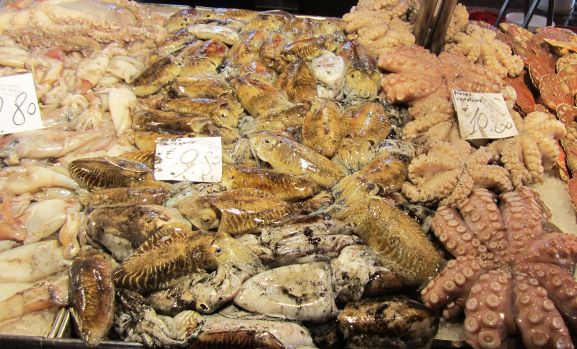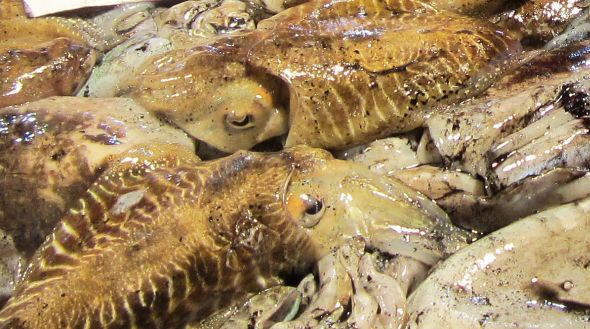
A super-sharp friend has just written to me, and apart from remarking pleasantly on my prose and panache, and admiring my musings on cuttlefish and the meaning of life (I think that was what I was doing), asked me why I didn’t explain how to cook them.
This blast of practicality was just what I needed, the perfect antidote to wandering around discoursing on how the once-delectable and desired seppie had become, through exaggeration, just Something Else to be Dealt With in Life.
I will now describe the process, in the style of Mrs. Beeton and others of her era, who were not too precise about quantities of ingredients (example: “a wine glass” amount of something. What wine? Bordeaux? Chardonnay?). But I will approximate as best I can. Here is the recipe according to Chef Lino of the Trattoria Bella Venezia, otherwise known as our kitchen:
INGREDIENTS:
2 pounds of seppie, cut in bite-sized pieces, with the ink sacs removed and put aside
extra virgin olive oil
1/3 cup chopped onion
1/2-3/4 cup of tomato sauce (not seasoned, just cooked strained tomatoes) OR
a big squirt of tomato paste, diluted
Salt
Pepper
TO COOK:
Saute’ the onion in a biggish pot.
Add the tomato sauce.
Add lots of water (1 1/2 quarts, more or less).
Add some salt and pepper (the seppie need to cook with some salt, but I suggest putting a minimum amount because as the sauce cooks down, the salty flavor will become stronger).
Bring to boil.
When the liquid boils, add the pieces of seppie, and the “latti” also (see below).
Take the ink sacs one by one, gently tear them to release the ink into the water, and drop the sacs into the water.
Simmer the seppie in the blackish liquid until the sauce is reduced to a thickish consistency and the pieces are tender.
Eat with pasta, eat as risotto, eat with polenta.
Two notes:
Watch the heck out for the ink as you work with it (and the inky sauce, too) because it makes a stain which is virtually impossible to remove from fabric. Or wear black clothes.
Whether you prepare pasta or risotto, you not only are permitted, you are essentially required, to add grated Parmesan cheese. Venetians don’t put cheese on any fish dish, as far as I know, but seppie requires it. I’ve tried seppie without cheese, and it has a wan, Little-Match-Girl sort of flavor. Try it yourself if you doubt me.

CLEANING SEPPIE:
This section is a public service.
I suppose that whatever fish market sells cuttlefish in your neighborhood will have someone capable of removing all the inedible bits before you take them home. But Lino does the operation himself, and if you were ever to want to see a perfectly happy man, you would have to see Lino cleaning seppie. But he can’t clean yours, so if any brave reader wants to chance his or her arm, here is how you do it.
Press outward on the head so that the mouth comes forward. Pull it out. Be careful, because there is a very sharp little “beak” in there.
Make an incision with a sharp knife in each eye, then press behind them in such as way as to make the whole eye apparatus come out.
Taking the body of the seppie in both hands, press against it toward the head, in order to push out the solid white cuttlebone. If you have any friends with birds, you can give it to them and make them happy.
Make an incision in the back of the cuttlefish and open it. You will see the ink sac. Remove it v-e-r-y c-a-r-e-f-u-l-l-y. Of course, if you don’t want to put ink in the sauce, just throw it away, but I think eating seppie without their ink is like writing without verbs.
Put each ink sac into a small container for the moment; Lino uses an espresso cup.
Inside the seppia you will see two smallish white globes with a small red mark on them. These are the “latti,” or “latte,” and are the ovaries, if you want to know. Remove them and keep them to add to the pot. (Or, you can boil them, add some salt, pepper, and olive oil, and you’ve got one fantastic little antipasto.)

Now tug on the edge of the seppia’s body and pull off the skin. It may come off in pieces. Persevere.
Cut the flayed seppia into bite-sized pieces.
You’re done. Go give yourself a reward.

4 Comments
I love seppie, although here in Sydney, Australia they’re not always available (although calamari are plentiful) as only Italians, Greeks and the Spanish seem to eat them. But your post reminded me of a story I did last year on my blog about cuttlefish and San Sebastian – two of my favourite things. Here it is: http://ambradambra.wordpress.com/2013/11/27/spanish-cuttlefish-with-italian-attitude/
Hmm iis anyone else experiencing problems with the pictures on this blog loading?
I’m trying to find out if its a problem on my end or if it’s the blog.
Any responses would be greatly appreciated.
I’m very sorry that this is happening. I have only heard of this one other time, so I would hazard to say that it’s something at your end. I can’t say what it might be, but I hope you have an expert somewhere who can resolve it.
This meal is for the brave, maybe someday, thank you for sharing!